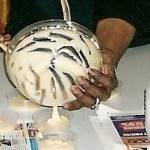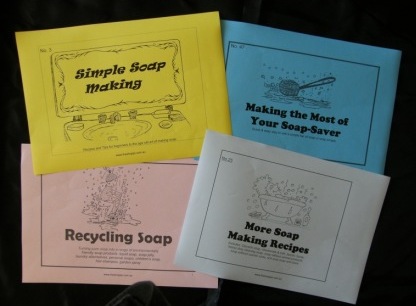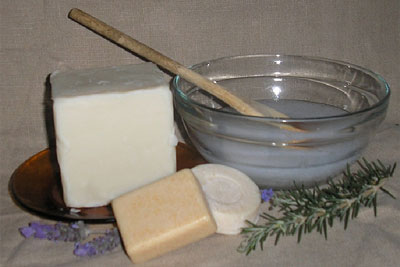Soap-Making
Kitchens were used for not only food preparation but for a variety of other essential household duties. Soap was an important product in every household.
Making your own soap is surprisingly simple and very rewarding. Soap consists of three basic ingredients: Lard (fat), water and caustic soda (the cleaning agent). Other ingredients are added for texture and aroma – such as oatmeal, oil, herbs, etc.
People are often intrigued by how quick and easy it is to make soap – the only ‘delay’ is that it takes three weeks for homemade soa p to ‘mature’ ready for use. Many people are concerned about the ‘caustic’ component of soap – however for soap to ‘clean’ it needs to contain some type of cleaning agent – caustic soda being the most appropriate and accessible for the home soap-maker. Only about 2-3% of the soap is caustic soda – once it is diluted with the other ingredients its potency is no longer a problem.
p to ‘mature’ ready for use. Many people are concerned about the ‘caustic’ component of soap – however for soap to ‘clean’ it needs to contain some type of cleaning agent – caustic soda being the most appropriate and accessible for the home soap-maker. Only about 2-3% of the soap is caustic soda – once it is diluted with the other ingredients its potency is no longer a problem.
Publications:
Soap-M aking e-Booklet Set
aking e-Booklet Set
Basic soap-making technique (with numerous recipe variations) plus many other uses for a simple bar of soap or soap scraps. 4 Booklets: No. 3 – Simple Soap-Making, No. 25 – More Soap-Making Recipes, No. 50 – Recycling Soap and No. 47 – Making the Most of your Soap-Saver.
(Available for instant download) Price: $33.00 ADD TO CART
Click here for information about e-Booklet Sets.
Other Relevant e-Booklets: No. 14 – Natural Hair Care (making soap-based shampoos and other hair care products) No. 23 – Green Cleaning (soap jelly alternative to detergents) No. 37 – Beautiful Baths (safe soap-based options, such as bubble-bath, soap-balls, bath-bags). All available for download from The Shoppe publications
______________________________
Living in Harmony with the Planet Workshops
 Soap Making Workshop@Home
Soap Making Workshop@Home
Making plain soap simply and quickly. Easy to follow basic recipe with numerous variations. Transforming a bar of soap into a range of alternative soap-based products (detergent alternatives). Safe & environmentally friendly.
Recipes and procedures for making: Basic soap (like Grandma used to make) with 10 variations, soap bag, English wash balls, Soap crayons (for the children), pressed soap shapes, herbal wash-balls, rose liquid hand soap
The Basics: To make all the products in this workshop you’ll need: cooking lard or fat (from the supermarket), olive oil, caustic soda, washing soda (or bicarb soda), bar of soap (or left-over soap scraps), recycled containers, oatmeal, food colouring. 33 pages of recipes, procedures and information. Price: $25.00 Available for immediate download. ADD TO CART
______________________________________________________
 Pam’s Post
Pam’s Post
As a child on the farm I watched my grandmother make ‘bush’ soap using wood ash (from an outdoor fire), water and sheep lard (which she rendered down from the sheep carcass). She would make the soap outdoors in an old kerosene tin over an open fire. Being very experienced at making soap this way she would boil it for some time until it reached just the right consistency to set (when cold) to form hard bars of soap (that lasted much longer than the commercial counterpart!).
Although my soap-making ventures are not quite so ‘rustic’ – I still get great pleasure from creating old fashioned bars of hard soap that last much longer (and froth less) than commercial soap.
Soap is a more natural alternative to detergents. Refer to the ‘Green Cleaning’ section for more information about soap and detergents. Booklet No. 50 is one of the most resourceful from the booklet range – as it outlines how to transform a simple bar of soap into various soap-based products to replace detergents in the home.
- Pam Marshall

